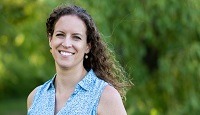Dr. Jessica Trier has been an assistant professor at Queen’s University in the Department of Physical Medicine & Rehabilitation (PM&R) since 2014. She completed her undergraduate degree and medical school training at the University of Western Ontario, before making her way to the University of Ottawa for residency. “I came to Queen’s University mainly because the job was the perfect combination – brain injury medicine, electromyography (EMG), and I had the opportunity to do both those things from a clinical standpoint,” Dr. Trier says. “From a scholarly standpoint and outside of clinical work, the opportunities in medical education helped launch my career, so I came to the right place at the right time.”
Department of Physical Medicine & Rehabilitation (PM&R) since 2014. She completed her undergraduate degree and medical school training at the University of Western Ontario, before making her way to the University of Ottawa for residency. “I came to Queen’s University mainly because the job was the perfect combination – brain injury medicine, electromyography (EMG), and I had the opportunity to do both those things from a clinical standpoint,” Dr. Trier says. “From a scholarly standpoint and outside of clinical work, the opportunities in medical education helped launch my career, so I came to the right place at the right time.”
Dr. Trier’s clinical title is Medical Director of the acquired brain injury rehabilitation program at Providence Care Hospital (PCH), where she provides care for inpatients and outpatients with brain injuries. “My other clinical work is electrodiagnostic medicine, which includes managing complex peripheral nerve injuries in the Kingston Peripheral Nerve Clinic (KPNC), a multidisciplinary collaboration with plastic surgery and orthopedic surgery.” Dr. Trier’s primary research interest, however, is in medical education. “My other position is CBME (competency-based medical education) Lead for PM&R. I took the lead along with our Program Director Dr. Sussan Askari to transform the curriculum into CBME, where coaching feedback is essential. Relationships between teachers and learners in the clinical environment is where my research lies.”
Dr. Trier was a successful candidate for MEDP funding from SEAMO and she is working on her Masters of Health Professions Education from Maastricht University in the Netherlands. As part of this work, Dr. Trier is seeking to understand why physicians do things the way they do in medical education. “Having lived experience in implementing a new CBME curriculum and the national rollout of Competence by Design in our specialty in 2020, it was a good time to ask questions about theories of education and if there was a better way to help our learners. So what I’m working on now related to my master’s thesis is creating psychological safety in the learning environment,” Dr. Trier explains. “Psychological safety is the sense it’s safe to take interpersonal risks in the workplace. My thesis is going to look at the risks residents take on a daily basis, how residents navigate that balance between safety and risk, and how that impacts their learning.”
When thinking about risks, patient safety is top of mind, according to Dr. Trier. The kinds of risks she is studying are different. “As faculty, we don’t appreciate risks as much as residents do. It might feel unsafe for residents to speak up and ask a question because they want to manage others’ impressions of them.” She goes on to explain residents are a different group than medical students in that they have more autonomy and are expected to function a lot more independently. “It’s an important group to explore between highly-supervised learner and practicing physician.”
Living these principles of psychological safety every day with learners is key to the physician’s teaching. “I want to model effective coaching. I hope some of the work I’m doing will spread to different contexts and gives us a better understanding of how to implement education systems that are effective and safe,” she says.
One thing Dr. Trier wants people to know is one cannot assume good clinicians will also be good teachers. “We need to look at the skills we expect people to have when delivering curricula like this. We assume great clinicians will be great teachers or coaches or mentors, and in fact there’s a whole different set of skills that come along with being a good coach. Those are skills we need to deliberately develop,” she says. “I hope that we’ll see some evolution of that over time in terms of having a better understanding of how to develop those coaches’ skills so we can really ultimately optimize the potential growth of our learners to make them the best clinicians and researchers and human beings possible.”
